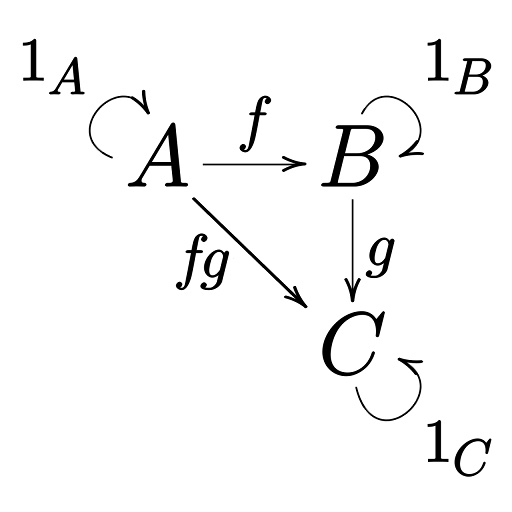Exploring Algebraic Structures: Categories, Groups, and Groupoids

In modern mathematics, algebraic structures offer a powerful language for expressing symmetry, computation, and relationships between objects. In this post, we’ll explore three fundamental structures: categories, groups & monoids, and groupoids. Each section introduces the basic definitions and gives concrete examples to bring the abstract concepts to life.
1. Categories and the Category of Sets
A category is a mathematical structure that abstracts the idea of objects and the relationships (called morphisms) between them. Categories provide a unified framework for discussing many different mathematical systems.
Definition: Category
A category consists of:
-
A collection of objects (denoted ),
-
A collection of morphisms (also called arrows) between objects. A morphism goes from object to object ,
-
For each object , an identity morphism ,
-
A composition rule: if and , then there is a morphism .
They must satisfy:
-
Associativity:
,
-
Identity laws:
Example: The Category of Sets
The most familiar category is , where:
-
Objects are sets (like ),
-
Morphisms are functions between sets,
-
Composition is the usual function composition,
-
Identity morphism is the identity function .
In , associativity and identity laws are satisfied naturally by function composition.
2. Groups and Monoids
Groups and monoids are algebraic structures that capture the idea of combining elements.
Definition: Monoid
A monoid is a set with:
-
A binary operation (often written as multiplication),
-
An identity element ,
such that:
-
Associativity: for all ,
-
Identity: for all .
Definition: Group
A group is a monoid where every element also has an inverse. That is:
- For each , there exists such that
Example: Integers and Natural Numbers
-
The set of integers with addition forms a group:
- Identity: , inverse of is .
-
The set (non-negative integers) with addition forms a monoid:
- Identity: , but most elements don’t have inverses (no negative numbers), so it’s not a group.
Groups capture symmetry—you can do and undo an operation. Monoids capture processes—you can combine actions, but not necessarily undo them.
3. Groupoids and Symmetries with Partial Inverses
A groupoid generalizes the idea of a group by allowing partial symmetries between different objects. Instead of a single set, we now think in terms of objects and invertible morphisms.
Definition: Groupoid
A groupoid is a category where:
-
Every morphism is invertible, i.e., for every , there exists such that
In other words, a groupoid is like a group, but with possibly many objects, and morphisms only between some pairs of objects.
Example: The Fundamental Groupoid of a Space
Let be a topological space. The fundamental groupoid is a groupoid that captures how points in are connected by paths (up to deformation). It is defined as follows:
-
Objects: the points of .
-
Morphisms: a morphism from to is a homotopy class of paths from to .
A path from to is a continuous function:
Two paths and from to are considered equivalent if there exists a homotopy between them—i.e., a continuous function:
such that:
for all . This ensures the endpoints stay fixed during the deformation.
-
Composition: if and are morphisms, then their composition is the homotopy class of the concatenated path:
where first follows from to , then from to (reparametrized to fit in ).
-
Inverses: each path has an inverse path given by:
This defines an inverse morphism .
Connection to the Fundamental Group
If we fix a base point , then the set of morphisms from to itself in the groupoid forms a group, called the fundamental group of at , denoted .
So is a group of loops at up to homotopy, with group operation given by concatenation of loops.
This shows that the fundamental group is just a special case of the more general structure of a groupoid, where we allow paths between all points in , not just loops based at a single point.
Closing Thoughts
These algebraic structures—categories, monoids, groups, and groupoids—form the language of modern mathematics, from algebra and geometry to computer science and logic. Understanding them provides a unifying perspective and opens doors to deeper theory, including functors, natural transformations, and higher category theory.